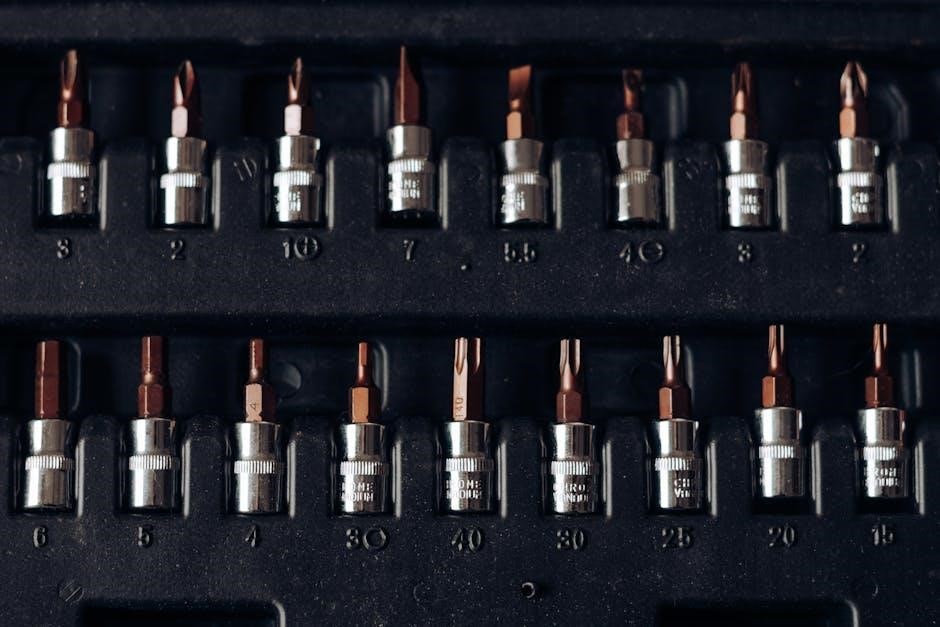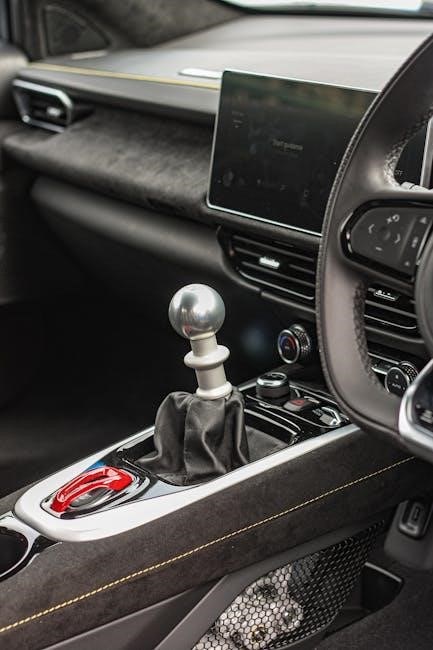The Baofeng F8HP is a dual-band‚ dual-display‚ dual-watch radio offering secure and reliable communications. As an upgraded version of the UV-5R‚ it ensures peak efficiency. The comprehensive 86-page user manual covers initial setup‚ safety‚ and operation‚ making it ideal for amateur radio operators and professionals seeking a portable‚ efficient communication solution.
1.1 Overview of the Radio
The Baofeng F8HP is a VHF/UHF dual-band transceiver designed for reliable communication. With an 8-watt output‚ it supports narrow and wide band coverage‚ making it suitable for both amateur and professional use. The radio features VFO and channel modes‚ CTCSS/DCS tone codes‚ DTMF encoder‚ and an FM radio function. Its built-in flashlight‚ ANI code‚ and emergency tone burst add to its versatility. The F8HP is an upgraded version of the UV-5R‚ offering improved performance and efficiency for secure and instant communication needs.
1.2 Key Features and Benefits
The Baofeng F8HP boasts dual-band operation‚ allowing communication on both VHF and UHF frequencies‚ with an 8-watt output for extended range. It supports narrow and wide band coverage‚ catering to various transmission needs. Features like VFO and channel modes offer operational flexibility‚ while CTCSS/DCS codes enhance privacy by filtering communications. The DTMF encoder enables tone-based operations‚ and the built-in flashlight and emergency tone burst provide practicality and safety. Designed for both amateur and professional use‚ the F8HP is a versatile and reliable communication tool.

Initial Setup and Safety Information
Proper setup ensures optimal performance and safety. Read the manual carefully‚ follow safety guidelines‚ and assemble the radio correctly. Avoid modifications and use only approved accessories to maintain reliability and compliance with safety standards.
2.1 Safety Precautions

The Baofeng F8HP requires adherence to specific safety guidelines. Only qualified technicians should service the radio‚ and modifications are strictly prohibited. Use solely BAOFENG-approved batteries and chargers to prevent damage. Ensure compliance with RF exposure limits and read the included safety guide thoroughly. Proper handling and setup are crucial for safe operation and reliability.
2.2 Unboxing and Assembly
Upon unboxing the Baofeng F8HP‚ you’ll find the radio‚ antenna‚ battery pack‚ charger‚ belt clip‚ and user manual. Begin by attaching the battery pack securely to the radio. Next‚ screw the antenna into the SMA-Female connector on top. Ensure all accessories are properly fitted. Charge the battery fully before first use‚ using only the provided or approved chargers. Familiarize yourself with the manual to understand each component’s function. Proper assembly ensures optimal performance and longevity of your device.

Basic Operation
Power on the radio using the side button. Adjust volume with the up/down keys and set squelch to minimize background noise. Use the PTT button for transmissions‚ ensuring clear communication. Refer to the manual for detailed steps on basic functions and settings to optimize your experience.
3.1 Turning the Radio On/Off
To power on the Baofeng F8HP‚ locate the power button on the side of the radio. Press and hold it until the LCD display lights up‚ indicating the radio is active. The device will automatically perform a self-test and display the current channel or frequency. To turn it off‚ press and hold the same button until the display turns off. Always ensure the battery is properly installed and charged before use. Improper handling of the battery may cause damage. Refer to the manual for detailed instructions.
3.2 Adjusting Volume and Squelch
The Baofeng F8HP allows easy adjustment of volume and squelch for optimal communication. Use the volume knob on the top of the radio to increase or decrease the speaker’s loudness. The squelch knob‚ typically located near the volume control‚ adjusts the threshold for signal reception‚ silencing weak or unwanted signals. Turn the squelch counterclockwise to reduce interference and clockwise to tighten the squelch. Ensure the squelch is set appropriately to balance noise reduction and signal clarity for clear communication.
3.3 Basic Communication Techniques
Mastering basic communication on the Baofeng F8HP involves key steps. Press and hold the PTT button to transmit‚ ensuring clear speech into the microphone. Release the PTT to receive. Use call signs for identification and maintain a structured format for messages. Monitor the channel before transmitting to avoid interference. Adjust volume and squelch for clarity. Keep conversations concise and use standard radio etiquette‚ such as “over” and “out‚” to facilitate smooth communication. Proper techniques ensure effective and clear interactions.

Advanced Features
The Baofeng F8HP offers advanced features like channel programming‚ CTCSS/DCS codes‚ and scanning modes. It supports high-power output‚ VFO and channel modes‚ and built-in tools like flashlight and FM radio‚ enhancing versatility and efficiency for users.
4.1 Channel Programming
The Baofeng F8HP supports programming of up to 128 channels across VHF and UHF frequencies. Users can manually program channels using the radio’s menu system or via external software. Each channel can be customized with specific frequencies‚ bandwidths‚ and tone codes (CTCSS/DCS). The radio also allows setting squelch levels and scanning options for each channel. This feature enables personalized communication setups‚ ensuring efficient and organized use of available frequencies. Proper channel programming is essential for optimal performance and interference-free communication.
4.2 Using CTCSS/DCS Codes
The Baofeng F8HP supports CTCSS (Continuous Tone-Coded Squelch System) and DCS (Digital Code Squelch) codes to filter radio communications. These codes allow users to only receive transmissions from specific groups or individuals‚ reducing unwanted interference. CTCSS offers 38 tone options‚ while DCS provides 104 digital codes. Codes can be set manually via the menu or through programming software. Properly configuring these codes ensures secure and efficient communication‚ minimizing unwanted chatter and enhancing privacy in group operations.
4.3 Scanning Modes
The Baofeng F8HP offers versatile scanning modes to monitor multiple frequencies efficiently. In VFO mode‚ it scans frequencies in predefined steps‚ while Channel mode scans saved channels. Priority scanning allows monitoring of a primary channel while scanning others. The radio supports both wide and narrow bandwidths‚ enhancing signal clarity. Users can customize scan lists and set scan intervals for optimal performance. These features make the F8HP ideal for monitoring multiple frequencies‚ ensuring rapid access to critical communications in dynamic environments.

Troubleshooting
Common issues include poor reception‚ low volume‚ or no power. Resetting the radio‚ checking battery connections‚ and ensuring proper antenna use often resolve these problems quickly.

5.1 Common Issues and Solutions
Common issues with the Baofeng F8HP include low volume‚ static‚ or no power. To resolve these‚ ensure the battery is fully charged‚ check antenna connections‚ and adjust squelch settings. For programming issues‚ reset the radio or re-program channels using the manual. If the radio fails to turn on‚ verify battery installation and charger functionality. Refer to the troubleshooting guide in the manual for detailed solutions and maintenance tips to ensure optimal performance and extend the device’s lifespan.
5.2 Resetting the Radio
To reset the Baofeng F8HP‚ locate the reset button on the rear of the radio. Use a small tool like a paperclip to press and hold the button while powering on the device. Release the button when the LED lights up. This restores factory settings‚ erasing all custom channels and configurations. Resetting is useful for resolving software-related issues but does not fix hardware problems. After resetting‚ reprogram the radio and restore your settings as needed.

Accessories and Maintenance
Essential accessories include the battery‚ charger‚ and antenna for optimal performance. Regularly clean the radio and store it in a dry place to prevent damage.
6.1 Recommended Accessories
Key accessories for the Baofeng F8HP include a high-capacity 3600mAh battery for extended use‚ a desktop charger for convenient charging‚ and a high-gain antenna for improved signal reception. A programmable cable is essential for software updates and channel customization. Additionally‚ a Nagoya NA-771 antenna enhances performance‚ while a tactical earpiece provides discreet communication. A car adapter ensures mobile use‚ and a protective case safeguards the radio during transport. These accessories enhance functionality and ensure optimal performance in various operating conditions.
6.2 Battery Care and Charging
Proper care and charging are essential for maintaining the Baofeng F8HP battery’s performance and longevity. Use only Baofeng-approved batteries and chargers to prevent damage. Avoid overcharging‚ as it can degrade battery life. Store batteries in a cool‚ dry place when not in use. Charge the battery to 50-80% for long-term storage. Ensure the battery is fully charged before prolonged use. Clean contacts regularly to maintain optimal conductivity. Follow the manual’s guidelines for charging cycles to preserve battery health and ensure reliable operation.

Technical Specifications
The Baofeng F8HP is a dual-band VHF/UHF radio with selectable 8-Watt output‚ offering narrow and wide band coverage. It supports VFO and Channel modes‚ CTCSS/DCS tone codes‚ DTMF encoding‚ and features an FM radio‚ built-in flashlight‚ ANI code‚ and emergency tone burst functionality for enhanced communication capabilities.
7.1 Frequency Range
The Baofeng F8HP operates on dual-band frequencies‚ covering VHF (136-174 MHz) and UHF (400-520 MHz). It supports wide and narrow band coverage for versatility in communication. The radio ensures compatibility with standard amateur radio frequencies‚ making it suitable for both personal and professional use. Its frequency range allows for reliable performance across various environments‚ adhering to FCC standards for amateur radio operations. This range ensures clear and efficient communication in diverse settings‚ from urban to outdoor applications.
7.2 Output Power
The Baofeng F8HP offers selectable output power of 1W‚ 4W‚ and 8W‚ ensuring flexibility for various communication needs. The adjustable power settings allow users to optimize battery life and signal strength. High power (8W) is ideal for long-distance communication‚ while lower settings conserve energy. This feature enhances the radio’s efficiency and adaptability in different environments‚ making it suitable for both amateur and professional use. The variable output power ensures reliable performance without compromising portability or convenience.














































